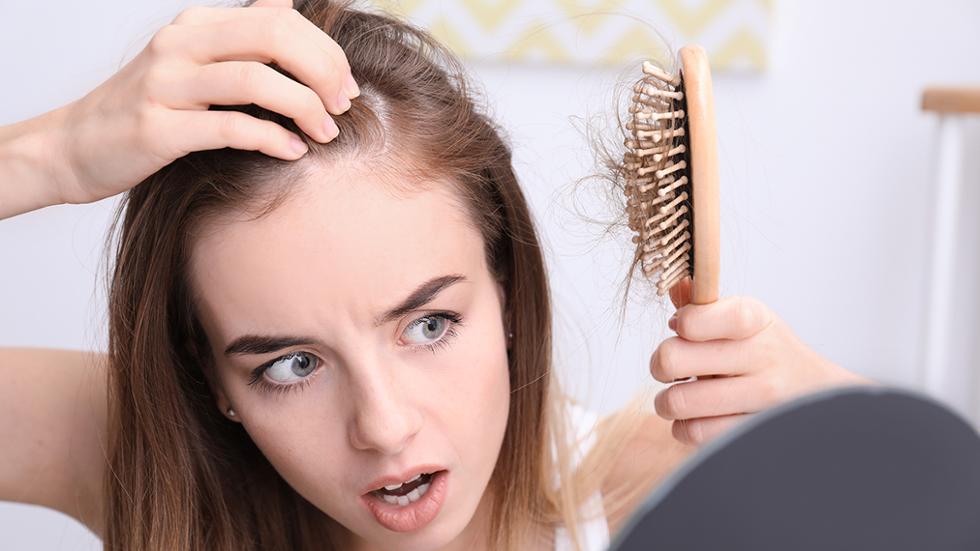
Finding hair in your brush is normal: We shed hair everyday. But if a person starts losing an unusual amount of hair, it can be cause for concern.
Hair loss normally doesn’t have much effect on your appearance or warmth, as your head has plenty more to make up for the daily loss. But there may be a more significant reason when you start seeing your scalp or bald spots.
When you think of hair loss, you may think of the genetic factors, such as male pattern baldness. Hormones, thyroid problems, and other diseases can all cause hair loss too.
So, what are these various causes, and how do you know if they’re to blame for your excessive shedding? Here are some scientifically proven reasons why you may be having hair loss
Hormonal changes
Women may lose hair following childbirth or while in menopause. Women who have hormonal imbalances can lose hair.
Aside from genetic male pattern baldness, men can lose hair as their hormonal composition changes with age. Hair loss is caused by your follicles’ response to the hormone dihydrotestosterone (DHT).
Thyroid Disorders
Perhaps one of the most common hormone-related causes for is a thyroid problem. Both too much thyroid hormone (hyperthyroidism) and too little (hypothyroidism) can lead to hair loss. Treating the thyroid disorder can often reverse the hair loss.
Severe and prolonged hypothyroidism and hyperthyroidism can cause loss of hair. The loss is diffuse and involves the entire scalp rather than discrete areas. The hair appears uniformly sparse. Regrowth is usual with successful treatment of the thyroid disorder, though it will take several months and may be incomplete.
Stress
Physical and psychological stress can cause hair loss. Surgery, high fevers, and blood loss can cause enough stress to result in excessive shedding. Childbirth can result in hair loss for several months after delivery.
As for psychological stress, the link is less well-defined. However, many people have reported losing hair at times of extreme mental stress or anxiety. And hair loss for other reasons can still be stressful.
The causes of physical stress are often temporary, and the hair loss subsides as the body heals.
You can combat mental stress with lifestyle changes, such as:
- daily exercise
- proper nutrition
- meditation and other stress management strategies
- removing known stressors from your life
Medication
Pharmaceuticals can come with a long list of side effects, including hair loss. Chemotherapy is the most well-known cause, but others include:
- thyroid medications
- some oral contraceptives
- beta-blockers
- anticonvulsants
- antidepressants
- anticoagulants
These medications affect people differently and happen in everyone.
Nutritional deficiencies
Zinc and iron deficiency are the most common nutritional links to hair loss. But some evidence indicates that low intakes of the following vitamins and nutrients could also be to blame:
- fats
- vitamin D
- vitamin B-12
- vitamin C
- vitamin A
- copper
- selenium
- biotin
How much hair loss is normal ?
Hair with plenty of volume, movement, and shine is what most people consider healthy. So when you look down at the drain and see a clump of lost hair strands, it’s easy to assume that there’s a health problem causing hair loss. But it is normal for everyone and at every age.
When you wash your hair thoroughly in the shower, hairs that are already loose or disconnected from your scalp congregate near the drain. While it might look like a lot, you’re probably seeing normal hair shedding.
If you’re experiencing hair loss that’s unusual for you, including bald spots, patchiness, and clumps of hair falling out, you should see your primary care physician or dermatologist. Keep reading to find out if you are shedding a normal amount of hair each day.
How much hair loss is normal in a day?
According to the American Academy of Dermatologists, it’s normal to lose anywhere from 50 to 100 strands of hair per day. For people with longer hair strands, losing them may be more noticeable. Since there are 100,000 hair follicles or more on each person’s scalp, the loss of 100 or so hair strands a day doesn’t make a big difference in appearance.
The hair life cycle
Many people think that hair just grows and sheds , end of question . However , our hair actually grows and dies in phases and nutrition, stress, hygiene, and daily styling all play a role in how much hair you lose daily.
The anagen phase is the first stage by which 90 percent of your hair strands are starting to grow on an average of 1 centimeter per month . When something stops your hair from growing, it’s called anagen effluvium.
The catagen phase is the second stage by which 1 to 2 percent of your hair stops growing . This phase only lasts about 2 to 3 weeks.
The telogen phase is the last stage of hair growth . Hairs in the telogen phase are also called “club hairs.” During this phase, a hair strand will be at rest as it prepares to detach from your scalp. About 8 to 9 percent of your hair is in this phase at any given time.
Telogen effluvium describes having more than 10 percent of your hair in the telogen phase. Telogen effluvium is temporary, but more hair will fall out while you have it. Stress, surgery, or even having a fever for a few days can bring on telogen effluvium, but your hair will probably be back to normal within six months.
Conclusion
See your doctor if you’re concerned about how much hair you are losing every day. A gradual thinning on the top of your head, the appearance of patchy or bald spots on your scalp, and full-body hair loss are signs that there may be an underlying health condition. A doctor will be able to assess whether if it is just normal shredding. You can also consider a hair transplant surgery if your hair loss gets too severe .

